Preschool Language Scales | Fifth Edition
PLS-5- PLS™-5 Preschool Language Scales Fifth Edition offers a comprehensive developmental language assessment with items that range from pre-verbal, interaction-based skills to emerging language to early literacy. Guidance on using this test in your telepractice.
Choose from our products
-
Kits
Starter & complete kits, print & digital
6 options
from $444.00 -
Test forms & reports
Booklets, record forms, answer sheets, report usages & subscriptions
4 options
from $16.75 -
Support materials
Manuals, stimulus books, replacement items & other materials
7 options
from $72.00 -
All products
All tests & materials offered for PLS-5
17 options
from $16.75
-
PLS-5 Basic Kit without Manipulatives (Print)
0158658906 Qualification Level BIncludes Examiner's Manual (Print), Administration and Scoring Manual (Print), Picture Manual (Print), 25 Home Communication Questionnaire (Print), 15 Record Forms (Print)
-
PLS-5 Complete Kit with Manipulatives (Print)
0158659880 Qualification Level BIncludes Examiner's Manual (Print), Administration Scoring Manual (Print), Picture Manual (Print), 15 Record Forms (Print), 25 Home Communication Questionnaire (Print), Complete Manipulatives Kit (2 rattles, 3 cups, bowls, 3 spoons, washcloth, 2 Cars for ages 3+, ball, 2 windup toys, squeaky duck, washable plastic bear, 2 cars for ages 6 months+, comb, box of eight crayons, pitcher, 2 children's books, opaque box with lid, 8 blocks). Kit does not include bubbles with wand, sheet of paper, metal keys on a ring, watch with a second hand or sealable plastic bags.
WARNING: CHOKING HAZARD - Small parts. Not for children under 3 years.
-
PLS-5 English/Spanish Complete Kits without Manipulatives (Print)
015865983X Qualification Level BIncludes PLS-5 English Complete Kit [Examiner's Manual (Print), Picture Manual (Print), Administration/Scoring Manual (Print), 25 Home Communication Questionnaires (Print), 15 Record Forms (Print)] PLS-5 Spanish Complete Kit [Spanish Examiner's Manual (Print), Spanish Picture Manual (Print), Spanish Administration/Scoring Manual (Print), 25 Spanish Home Communication Questionnaires (Print), 15 Spanish (bilingual) Record Forms (Print)]
-
PLS-5 English/Spanish Complete Kits with Manipulatives (Print)
0158659244 Qualification Level BIncludes PLS-5 English Complete Kit with Manipulatives [Examiner's Manual (Print), Picture Manual (Print), Administration/Scoring Manual (Print), 25 Home Communication Questionnaire (Print), 15 Record Forms (Print), Manipulatives set (2 rattles, 3 cups, 3 bowls, 3 spoons, washcloth, 2 Cars for ages 3+, ball, 2 windup toys, squeaky duck, washable plastic bear, 2 cars for ages 6 months+, comb, box of eight crayons, pitcher, 2 children's books, opaque box with lid, 8 blocks)], PLS-5 Spanish [Spanish Examiner's Manual (Print), Spanish Picture Manual (Print), Spanish Administration/Scoring Manual (Print), 25 Spanish Home Communication Questionnaire (Print), 15 Spanish (bilingual) Record Forms (Print), 2 Spanish children's books]. Kit does not include bubbles with wand, sheet of paper, metal keys on a ring, watch with a second hand or sealable plastic bags.
WARNING: CHOKING HAZARD - Small parts. Not for children under 3 years.
-
PLS-5 Record Forms Qty 15 (Print)
0158658965 Qualification Level B -
PLS-5 Record Forms Qty 50 (Print)
0158658973 Qualification Level B -
PLS-5 Home Communication Questionnaires Qty 25 (Print)
0158659287 Qualification Level B -
PLS-5 Q-global Home Communication Questionnaire For Age 0-35 Months (Digital)
A103000232007 Qualification Level BOnce ordered, the digital asset is accessible by logging into Q-global and visiting the Q-global Resource Library. It is a downloadable file.
-
PLS-5 Picture Manual (Print)
0158658949 Qualification Level B -
PLS-5 Q-global Picture Manual (Digital)
A103000232006 Qualification Level BOnce ordered, the digital asset is accessible by logging into Q-global and visiting the Q-global Resource Library. It is a view-only digital file.
-
PLS-5 Examiner's Manual (Print)
0158658930 Qualification Level B -
PLS-5 Q-global Examiner's Manual (Digital)
A103000232009 Qualification Level BOnce ordered, the digital asset is accessible by logging into Q-global and visiting the Q-global Resource Library. It is a view-only digital file.
-
PLS-5 Administration and Scoring Manual (Print)
0158658957 Qualification Level B -
PLS-5 Q-global Administration and Scoring Manual (Digital)
A103000232008 Qualification Level BOnce ordered, the digital asset is accessible by logging into Q-global and visiting the Q-global Resource Library. It is a view-only digital file.
-
PLS-5 Manipulatives
0158659899 Qualification Level BIncludes Plastic Bear, Comb, Crayons (8), Books (2), Pitcher, Cloth, Rattles (2), Ball, Plastic Bowls (3), Cups (3), Spoons (3), Squeaky Toy, Cars (3), Wind Up Toys (2), Box with Lid. Kit does not include bubbles with wand, sheet of paper, metal keys on a ring, watch with a second hand or sealable plastic bags.
WARNING: CHOKING HAZARD - Small parts. Not for children under 3 years.
-
CELF Preschool-3 Complete Kit / PLS-5 Basic Kit Combo (Print)
A103000185026 Qualification Level BIncludes CELF Preschool-3 Complete Kit [CELF Preschool-3 Manual (Print), Stimulus Book (Print), No Juice book (Print), 25 Record Forms (Print), 25 Pragmatics Profile/Preliteracy Forms (Print)] PLS-5 Basic Kit [PLS-5 Examiner's Manual (Print), Administration and Scoring Manual (Print), Picture Manual (Print), 25 Home Communication Questionnaire (Print), 15 Record Forms (Print), softcase
-
CELF Preschool-3 Kit / PLS-5 Kit with Manipulatives Combo (Print)
A103000185028 Qualification Level BIncludes CELF Preschool-3 Complete Kit [CELF Preschool-3 Manual (Print), Stimulus Book (Print), No Juice book (Print), 25 Record Forms (Print), 25 Pragmatics Profile/Preliteracy Forms (Print)], PLS-5 Kit with Manipulatives [PLS-5 Examiner's Manual (Print), Administration and Soring Manual (Print), Picture Manual (Print), 25 Home Communication Questionnaire (Print), 15 Record Forms (Print), Complete Manipulatives Kit (2 rattles, 3 cups, 3 bowls, 3 spoons, washcloth, 2 Cars for ages 3+, ball, 2 windup toys, squeaky duck, washable plastic bear, 2 cars for ages 6 months+, comb, box of eight crayons, pitcher, 2 children's books, opaque box with lid, 8 blocks)]. Kit does not include bubbles with wand, sheet of paper, metal keys on a ring, watch with a second hand or sealable plastic bags, softcase
WARNING: CHOKING HAZARD - Small parts. Not for children under 3 years.
Overview
- Publication date:
- 2011
- Age range:
- Birth—7:11
- Scores/interpretation:
- Total language, auditory comprehension, expressive communication standard scores, growth scores, percentile ranks, language age equivalents
- Qualification level:
- B
- Completion time:
- 45-60 minutes
- Administration:
- Pointing or verbal response to pictures and objects
- Scoring options:
- Manual scoring
- Telepractice:
- Guidance on using this test in your telepractice
Product Details
This play-based assessment comprehensive, reliable, and trusted information about language skills for children birth through age 7.
Benefits
- Address a wider variety of early play behaviors.
- Better elicit target responses due to test item modifications that are based on examiner feedback.
- Minimize transitions between the play and picture pointing tasks now that test items with manipulatives are grouped to streamline administration.
- Engage children with the new Picture Manual featuring large, colorful illustrations.
- Target multiple phonemes within words using the brief Articulation Screener, which now includes picture stimuli.
- Track progress using Growth Scores to monitor a child’s skills from Birth through age 7:11.
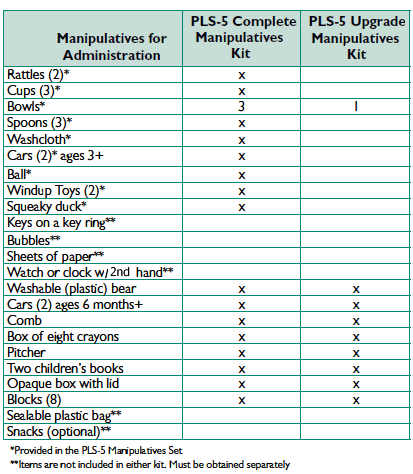
Features
PLS-5 provides assessment of preschoolers with new items for letter naming and book handling, and updated school readiness skills. Approximately 25 percent of PLS-5 items are new, 50% have been modified, and 25% are unchanged from PLS-4.
- The standardization sample matches updated U.S. Census figures for region, race/ethnicity, and level of caregiver education.
- Clinical studies include a developmental delay study and three language disorder studies (children with receptive language disorder, expressive language disorder, and both receptive and expressive disorder).
- Includes new language tasks such as assessing use of irregular plurals and synonyms, constructing sentences using two or three target words in the sentence, and answering questions about a story.
- Many of the manipulatives are plastic (including “Mr. Bear”) so they can be wiped clean after each administration.
Resources
The following resources are available for PLS-5.
FAQs
Select a question below to see the response:
PLS-5 Enhancements
Current Norms: The normative data for PLS-5 are now 10 years old. There has been a significant demographic shift from the time PLS-4 was standardized, with increasing diversity in the U.S. population and shifts in the socioeconomic status of families with children birth through age 7.
Streamlined administration: Some tasks were combined in PLS-5 to minimize shifts in administration that require excessive switching between presentation of manipulatives and the Picture Manual.
Improvements to test items: Clinicians working with young children have provided feedback over the years about how test items could be improved. PLS-5 includes modifications that better elicit target responses and make the items easier to administer and score. Approximately 25% of the items on PLS-5 are new; 50% have been modified based on clinician feedback and expert review; 25% are unchanged from PLS-4. See PLS-5.com for examples of new and modified test items.
Addition of Growth Scale Values: PLS-5 now includes Growth Scale Values that were developed so that you can track progress for children birth through age 7.
Now through age 7: Now you are able to assess language from emerging communication behaviors through emerging language and literacy skills through age 7:11. This will provide a single, standardized measure for children with significant deficits (such as children with autism) who are being tracked from a very young age through their early school years.
Updated Articulation Screener: You can now test multiple phonemes within words. PLS-5 includes picture stimuli to elicit target words. The screener takes less than 2 minutes to administer.
PLS-5 addresses a wider variety of early play behaviors: play with others (interaction & turntaking) and play with objects (functional and relational play). Use the two-page Home Communication Questionnaire to obtain information from caregivers who have a child whose language abilities are in the Birth through age 2 range. If the caregiver completes the Questionnaire before testing, you can score many of the test items without administering them to the child. This frees you up to observe naturally-occurring parent-child interactions during the testing session.
There are new items assessing emergent literacy skills such as book handling and concept of print. Many of the items at this level have been modified based on PLS users’ feedback!
The new items at age 7 include tasks such as using irregular plurals, using synonyms for a word, usign two or three target words to construct a sentence, and using prefixes.
Providing norms through age 7 enables clinicians to obtain standardized scores (including Growth Scale Values) to address the needs of children who:
Better demonstrate their language skills when provided with a variety of interactive test formats Have severe, persistent language deficits such as children with autism or severe developmental delays
Start Points and Age levels
The start point icon (the arrow) appears throughout the Record Form and the Administration and Scoring Manual. It indicates the recommended Start Point for the ages listed. It does not indicate the age at which the skill is mastered.

The bars marked “Developmental Tasks for Ages __–__ in the Record Form and Administration and Scoring Manual indicate the ages by which developmental tasks are mastered.

The age description you are referring to in the Record Form and Administration and Scoring Manual has an arrow icon in front of it (see an example above).
This arrow icon indicates that the age listed is the recommended Start Point for a child age 6 to 11 months. The icon does not indicate the ages at which the skill is acquired. The age band highlighted in gray or purple, such as, “Developmental Task for Ages 0:3–0:5,” shows the developmental ages for the task.
You will see differences in the age placement for some of the PLS-4 test items on PLS-5. Generally, the age placements in PLS–5 were adjusted to show the ages at which at least 90% of the children acquired the developmental skill. In PLS–4, at least 75% of the children had acquired the skill. Changing the criterion for item placement form 75-90% made it more likely that a child can achieve a basal on PLS–5 at the suggested start point without having to drop back and administer additional items.
For example, the test item “Responds to speaker by smiling” was Item 3 on PLS–4 and was placed as the most difficult item on PLS-4 for children ages birth through 2 months. On PLS–5, “responds to speaker by smiling” is Item 4, and is placed as the easiest item for ages 0:3–0:5.
Test Administration
We recommend that one or more of the following three criteria be met before PLS-5 can be re-administered:
- Re-testing should be conducted after the child no longer remembers the test items and/or his or her responses when tested previously
- Re-testing should be conducted when the examiner feels that the child has made progress since the previous test administration (otherwise, there is no reason to re-test)
- Re-testing can be conducted when the child’s age at testing results in the use of the next-age norms table to score.
Picture Manual
We actually have a prototype of a Picture Manual with plasticized “tear-resistant” pages that we will be piloting. The pages can be crushed then laid flat (it does leave some wrinkles, but the page is still usable) and can be wiped clean after use.
It appears that using this type of material in the manual would add approximately $125 to the cost of the kit. We do not yet know how much time is added to the manual’s shelf life with heavy use.
Manipulatives
You have the option of purchasing manipulatives sets or collecting your own. The PLS–5 manipulatives sets are included in the Complete Kit and Upgrade Kit for customers’ convenience. Examiners who participated in the PLS–5 standardization collected their own manipulatives to administer the test, so the normative data is based on a variety of manipulatives that meet the criteria described on pages 6–7 in the Examiner’s Manual. If you lose or break one of the manipulatives in the kits, you have the option of ordering a replacement from Pearson or using another item from your home or school (e.g., another box that has a lid) that meet the description in the Examiner’s Manual.
Squeaky toys that are made with latex (e.g., dog toys) have a very loud squeak when squeezed because they are stiffer than latex-free squeaky toys. The duck in the PLS–5 kit is latex-free and has a hole rather a whistle so that there are no loose parts. The duck has a louder squeak when squeezed in a way that maximum air is forced through the hole.
We used a sound level meter and ran a test with the ducks in stock. We found that the “squeak” ranged from approximately 60dB (approximately the noise level of normal conversation) to 80–90db (approximately the noise level of an alarm clock or vacuum cleaner). To get the loudest “squeak”, we recommend you squeeze the duck’s head and body together. See images below.

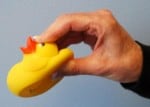

The squeak volumne tends to be low when the duck is squeezed from the sides and/or your thumb is covering the hole. It won't squeak loudly when you hold it like the images below.
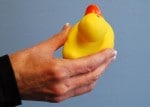

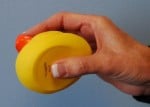
The requirement that one of the cars be blue is an error in the Examiner’s Manual. That will be corrected in the next printing of the Manual. There were no items tested during standardization that required that the cars be a specific color.
It is a tight fit–the bear and blue pitcher fit snugly (you have to push the bear down), and the bear’s ear sticks up in a way that you cannot fit the lid on the box and snap it shut. Place the bear and pitcher in the blue box as shown below and simply lay the lid on top. The new pitcher has been designed and completed child safety testing. The new pitcher is now available – call Customer Service at 800.627.7271 to obtain a replacement pitcher for each PLS-5 kit you purchased before February 2012.

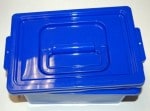

The plastic blue box in the test box is used to administer specific PLS-5 test items. It was not meant to be the manipulatives storage box. The large blue box labeled PLS-5 Manipulatives Set can be used for storage of the manipulatives.
Market research with PLS-4 customers showed that SLPs use a variety of methods to store and carry their test components. Some clinicians take all their test materials out of the shipping carton and place it on their shelves; others have their own rolling cases, bags, or boxes that they use to transport kits from one site to another. A majority of clinicians surveyed preferred to find their own storage and “transportation” solution to keep the overall kit price down. The PLS-5 kit was designed to minimize the price of the kit.
Two books come in the PLS-5 Complete Manipulatives Set and PLS-5 Upgrade Manipulatives Set.
Our company stocks three different wind-up toys and three different children’s books for the PLS-5. When you order a kit with manipulatives, the kit is assembled with two different wind-up toys and two different books randomly selected for inclusion in the kit.
The three books available are all the same level. The younger children are only tested on book handling or following directions with books (e.g., “Get the book and bring it here, please.” There are no test items for young children requiring Level 1 reading skills.
You can order any of the PLS-5 manipulatives individually (e.g., the bear, the blue box). The 2 English children’s books shrink-wrapped as a set (ISBN 0158658981.)
The best “deal” is purchasing the Complete Kit with Manipulatives. The Upgrade Manipulatives Kit includes the most expensive components of the manipulatives set, so current pricing for the Basic Kit without Manipulatives and the Upgrade Manipulatives Kit is only $11 less than the Complete PLS-5 Kit with all the manipulatives.
Scores
A child may earn a low score on only the AC or EC scale because the child has only a receptive or expressive language disorder. When that happens, the resulting Total Language score may not qualify the child for services.
Standard scores and percentile ranks are reported for the Auditory Comprehension and Expressive Communication scales as well as for Total Language ability. Each of these scores can be used by a clinician to determine if a child meets eligibility criteria under IDEIA for speech-language developmental delay or disorder. AC, EC, or Total Language scores (in conjunction with other test results) can assist a clinician in determining if the child has primarily a receptive language delay/disorder, expressive language delay/disorder, or a delay/disorder that involves both (see the PLS-5 Examiner’s Manual, p.3). Low standard scores or percentile ranks for Auditory Comprehension, Expressive Communication, or Total Language ability can be used to diagnose a disorder and qualify a child for services.
A PLS-4/PLS-5 study was conducted in 2010 with 134 children from the PLS-5 standardization sample. Each child’s PLS-5 Auditory Comprehension (AC), Expressive Communication (EC), and Total Language standard score was compared to the corresponding scores on PLS-4. On average, scores on the PLS-5 are 1 point lower on the AC scale, 1.5 points lower on the EC scale, and 1 point lower on the Total Language score in this study.
We realize that if a child receives PLS-5 standard scores that are even one point higher than PLS-4 standard scores that were borderline (e.g., 77), the child may no longer meet the district criteria for eligibility for services. As you will find in the PLS-5 Examiner’s Manual on page 16:
Because no test is perfectly reliable, the true score is expected to be within a range of scores that reflects the expected amount of measurement error…Using confidence intervals, rather than a specific single score enables you to state the degree of confidence you have in a classification, eligibility, or placement decision based on PLS-5 results. Therefore, reporting a confidence interval around a child’s score is particularly important in cases for which the score will be used to make those types of decisions.
You pointed out that you are working with districts with rigid eligibility cut offs—apparently that means the district does not take other test results (e.g., language sampling, observations in the classroom, teacher interviews) or the standard score confidence bands into account. These requirements do not align with IDEIA legislation, best testing practice, or appropriate PLS-5 test interpretation.
If you are testing a child who has made enough progress on developmental language skills that he or she no longer qualifies for services, but still shows deficits in specific language skill areas, we recommend:
Additional testing using CELF Preschool 2, which provides a more in-depth assessment of semantics, morphology, and syntax, and/or
Addressing the child’s language needs within a Response to Intervention (RTI) service delivery model.
In the PLS-4/PLS-5 study conducted in 2010, we found only a 1-2 point score difference between PLS-4 and PLS-5 (see the answer to the previous question)
Whenever a new edition of the test is published, you will see some differences in scores. The PLS-4 norms were collected in 2001; the PLS-5 norms were collected in 2010. In addition, there are differences between the PLS-4 and PLS-5 tasks. Those differences, coupled with the current normative information which includes test results from an increasingly diverse population, result in the score differences you are seeing.
If you are testing a preverbal child, or a child with limited verbal skills, his scores may be slightly higher on the Expressive Communication test because children at that level are now given credit for key developmental communication skills such as joint attention and using gestures.
Lots of concerns here:
If the child is fluent in English and just happened to give a few responses in Spanish, the responses in Spanish should be scored as incorrect. PLS-5 was normed with children whose primary language spoken is English. We did not norm the test with bilingual children who gave responses in another language. Not getting credit for a couple of responses in Spanish is not likely to tip the child into the disordered range of ability unless the child is giving a large number of answers in Spanish.
If the child is giving a large number of responses in Spanish, the child is clearly bilingual. Both PLS-5 and PLS-4 Spanish should be administered to evaluate the child’s skills in each language. When PLS-5 Spanish is published at the end of April or beginning of May, 2012, you will can administer PLS-5 Spanish to the child. With PLS-5 Spanish, you can assess both Spanish and English skills in one test and obtain a dual language score that reflects the child’s skills in both languages.
The PLS-5 norms are based on using the lowest basal and the lowest ceiling obtained--the one obtained at the lowest (youngest) age level.
Good question! The short answer: it is not an error or omission. AC 62a is a sentence that is grammatically correct. In the normative sample, it was found that a typically developing child will identify the sentence in AC 62a as "right" whether a child is a speaker of Mainstream American English (MAE) or a speaker of a dialect other than MAE. Children who were speakers of dialects other than MAE did not provide a dialectal response to AC 62a after identifying the item as "right," so no dialectal variations are listed in Appendix E. If a child identified the sentence as "wrong," he or she may introduce a grammatical error in his or her response (e.g., for AC 62a, the child answers, "They goin' the store" [omits "to"]). What was more likely to occur was the child responded with an objection to the content (e.g. for AC 62a, the child answers, "No, they goin' to school.") In both instances, AC 62a is scored incorrect (0).
The sentences in AC 62 b through AC 62 d are grammatically incorrect. Typically developing children speaking a dialect other than MAE may identify the sentence as "wrong" and may provide a dialectally appropriate response to correct the sentence. Dialectally appropriate responses are listed in Appendix E. These answers will be marked as correct. If the child identifies the sentence as "wrong," he or she will not receive credit (score=-0) if the response does not correct the grammatical error (e.g., AC 62b, a child who speaks English influenced by Spanish responds "Her can eat a cookie.") or is an objection to the content (e.g., for AC 62d, a child answers, "No, the girl ran slow.")
The PLS-5 normative data does not include children who were born prematurely. Best practice indicates that clinicians may choose to adjust for prematurity through the age of 24 months. Note that a premature birth is defined as 36 weeks or less gestation. To correct for prematurity, calculate the number of months and days born prematurely by subtracting the child’s date of birth from the expected date of birth. Subtract months and days born prematurely from the child’s chronological age. After age 24 months, it is not appropriate to adjust scores for prematurity.
Recycle Program
Each PLS-5 kit includes a mailing label so that you can ship your PLS-4 kit back to Pearson at no charge. Pearson will recycle manuals and record forms. If the mailing label was missing from your kit, you may contact us at www.psychcorp.com to request one.
PLS-5 Spanish
PLS-5 Spanish will publish in April 2012. It will feature a bilingual conceptual score so that the child’s language abilities in both Spanish and English are captured in one score.
When testing a bilingual child, the PLS-5 Spanish test items are administered in Spanish until a ceiling is reached. Then the clinician then looks at any items/subitems that were scored 0, and administers only the missed items/subitems in English until a ceiling is reached.
Yes, the manipulative sets are the same for the English and Spanish tests. If you already own the PLS-5 manipulatives, you may want to purchase the two children’s books in Spanish that are used to administer the literacy items (sold separately)
The PLS-5 English normative scores cannot be used with children who are not proficient enough in English to take PLS-5 in the standardized fashion.
Because PLS-5 is a test that assesses developmental language skills, many of the items in the English and Spanish editions do overlap. However, item placement differs on specific test items because the skills develop at different ages and some subitems are different or appear in a different order based on difficulty of the items in each language. In addition, the norm groups for the English and Spanish editions are rather different. The Spanish normative scores are based on a sample that represents the population of Spanish speakers in the U.S.
PLS-5 Screening and PLS-5 Spanish Screening
April, 2012
Unfortunately not; the visual stimuli for many of the pictures have changed. If you administer the PLS-4 Screening Test, you will need to administer all the PLS-5 items unless each sub-item within an item and each corresponding auditory and visual stimulus is completely unchanged from PLS-4.
Yes, the scores from the PLS-5 Screening Test can be transferred to the PLS-5 Record Form. You do not need to re-administer the test items when you administer PLS-5.
While some test items appear on both the English and Spanish tests, some items differ. The items selected for each edition of the Screening Tests are the most discriminating test items for English or Spanish speakers based on the normative data collected for the two groups. The articulation item set also differs across forms.
The items on the PLS-5 Spanish Screening Test were developed to test children who speak Spanish. It is inappropriate to use the English items on the Spanish Screening Test for children whose primary language is English because:
- The demographic characteristics of the Spanish sample differ significantly from the demographic characteristics of the sample collected for the English edition. You would not be comparing English speaking children to a comparable normative group.
- The English items on the Spanish Screening Test are translations of the Spanish test items. The English items were not ordered to reflect the order of difficulty or development sequence for English-speaking children.
Webinars
The following training events are available for Preschool Language Scales | 5th Edition

Available in Spanish!
Explore our full Spanish offering


